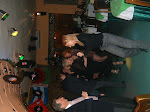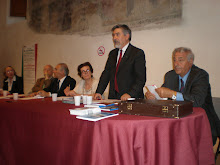March 5th 2014 | Multiple countries | Oil and gas | Gazprom
Europe does not face a gas crunch, but Russian actions in Ukraine could hasten efforts to shore up EU energy security.
Russia’s
intervention in Crimea has sent countless economic indicators hurtling
downwards—the Moscow stock market, for instance, and the Russian
rouble’s value against the US dollar. Others have shot skywards. Oil
prices, ever sensitive to political risk, fall in the latter category:
the threat of conflict has escalated. So too do natural-gas prices, the
upwards forces on which were compounded by a threat on March 1st by the
Russian state gas-export giant, Gazprom, to raise the price it charges
Ukraine. Yesterday Russia’s president, Vladimir Putin, confirmed Gazprom
will end the discount granted to Ukraine’s now ousted president, Viktor
Yanukovych, in December.
The
apparent willingness on Russia’s part to use its control over gas
supplies as a political tool rings alarm bells throughout Europe.
One-half of Russian supplies to the EU, which looks to Russia as a key
gas supplier but has sided with Ukraine’s new government, flowed through
Ukraine in 2013. Memories have been awakened of episodes in 2006 and
2009 when, amid pricing disputes, Russia cut off supplies to Ukraine at
the height of winter, causing European gas prices to spike. But this
time, while the threat of military clashes is higher, the energy risks
for Europe are not.
Dependent, but less so
Certainly,
EU reliance on Russian gas is still uncomfortably large, particularly
among its eastern members. But Europe is more resilient than it would
have been even a few years ago in the event of a relatively short break
in supplies, provided it lasts only a matter of days or weeks. Given
that Russia depends heavily on European gas demand, a longer switch-off
than this would be strongly against its interests too.
Not
only are Russian supplies less important for Europe than they used to
be, but Ukraine’s role as a gas-transit hub is also diminished. Opening
the Nord Stream pipeline through the Baltic Sea to Germany in 2011 gave
Russia a 55bn-cu-metre/year alternative route into Europe, less
vulnerable to disputes. (The Brotherhood pipeline across Ukraine can
transport over 100bn cu metres/y.) Spare capacity on Nord Stream and the
Yamal pipeline through Poland and Belarus gives Gazprom other ways to
get its gas to EU customers.
Heating up
For
Europe, moreover, the timing of the current flare-up could have been
much worse. A stoppage now would be far less serious than one in early
winter. Warmer months are ahead, meaning lower gas demand. First, Europe
must cope with March, the last cold month of the winter. But European
gas storage facilities are well-stocked: the UK’s, for instance, is
filled well above average levels at this time of year (Ukraine’s would
reportedly last four months if Russian supplies, which satisfy one-half
of Ukrainian gas demand, were cut). After all, EU gas demand has flagged
along with the economy. We expect it to grow by under 1% in 2014, as
economic activity recovers only mildly and coal remains cheap.
Seen
in a larger context, the consequences of the Ukrainian crisis for
European gas prices are also less dramatic than they may seem. Prices
had fallen appreciably in the months preceding the current rise in
tensions. The subsequent rebound, fuelled by fears of war rather than
physical supply limits, leaves them well below their previous peak.
What
if Russia did turn off the Brotherhood pipeline? One effect would be to
drive up LNG prices, already very strong especially in Asia. Cargoes
selling for US$18-19 per million British thermal units (mBtu) now could
then command more than US$20/mBtu. New LNG projects set to come online
in Papua New Guinea and Australia later this year will not help Europe
if Russian supplies falter soon. Expected output rises in Norway and the
UK in 2014 would help, but are not sure to materialise.
Make
no mistake, however: the biggest effect on energy markets of a shutdown
of gas exports through Ukraine would be on Europe’s coal demand. As in
recent years when gas has been expensive, the EU would burn greater
quantities of cheap coal to generate power. Plentiful supplies from the
US would help European consumers switch energy sources with relatively
little impact on their costs.
Looking to the long term: LNG
On
balance, though, the implications of events in Ukraine for European gas
supplies are less shocking than the dramatic events on the ground might
suggest, even in the event of a limited outage. This is in line with
comments yesterday from the EU’s energy commissioner, Guenther
Oettinger. "We are not concerned about short-term security of supply
[for the EU]," he said, while expressing anxiety about Ukraine’s energy
security. But the troubling recent events could nonetheless halt the
revival in Gazprom’s exports to Europe and strengthen the urge among
utilities there to seek other sources of supply.
Before
intervening in Crimea, Mr Putin seems likely to have calculated that
Europe relied too heavily on Russian gas to take strong action against
him. Taking the long view, he might assume the episode will have little
effect on the European market for Russian gas. Yet this logic could
possibly prove too sanguine. Although Europe does not currently face a
supply crunch, Russia’s actions could help concentrate European minds on
further shaking off dependence on Gazprom.
In
the long run, the effects of this could be felt in the LNG market. For
the EU, LNG imports are the readiest direct substitute for Russian gas.
Needless to say, increasing European LNG imports would threaten the
interests of Gazprom and Russia.
Certainly,
Europe will be constrained in any attempts to buy more LNG by
competition for limited supplies with gas-hungry Asia, where shipments
fetch higher prices. Still, Russian moves in Ukraine could play into the
hands of those in the US who argue it should speed up approvals for LNG
export facilities. A US boom in extracting natural gas from shale rock
has depressed gas prices there, but policymakers have been slow to
sanction LNG shipments. The pace of approvals has lifted in the US, as it has in Canada,
but building LNG-export infrastructure is a painstaking process.
Indeed, construction has only begun at one of the six facilities
approved by the US government so far.
Another
dampener is that Canadian and US gas would be destined mainly for Asian
markets—also true of supplies from the main LNG-market insurgent,
Australia. The prices of cargoes heading to Europe would have to account
for outlays on liquefaction and transport. Despite low gas prices
across the Atlantic, then, Europe would be unlikely to gain any price
advantages from buying North American gas. Still, a better-supplied
market should help European utilities if they seek further shipped gas
supplies.
If
they do so, there will be no shortage of LNG-receiving infrastructure
available to them (though the gas grid connecting heavily Russia-reliant
East and Central Europe would need further investment). Many European
LNG import hubs are under-used, as gas shipments have lost out to cheap
coal and piped gas imports. This is not stopping some countries,
conscious of their exposure to Russia, from adding capacity. Work on a
new terminal in Poland designed to ship in gas from Qatar, the top LNG
exporter, is due to be completed by end-2014. Estonia and Finland, both
EU member states and Gazprom-dependent neighbours of Russia, last week
resolved a dispute over which should build a new LNG terminal. In the
end, they decided to build one each.
Gazprom
wants to lift its share of European gas supplies even further, but
already faces stiff regulatory headwinds from the European Commission;
Russian actions in Crimea have hardly helped its cause. Europe still
needs Russia’s gas, but is now more likely to step up the search for
alternatives. Among Mr Putin’s few Western admirers may be LNG exporters
with their eyes on long-term profits.
Source: Industry Briefing



















































































.jpg)
.jpg)

Nessun commento:
Posta un commento